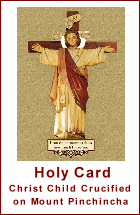What People Are Commenting
Book, Translations & Ballet
Our Lady of Good Success
TIA,
Good Evening!
I was reading about Dr. Horvat’s translation of Prior Manuel de Souza’s book [The Admirable Life of Mother Mariana, vols. I and II]. It seemed to me that I had heard some of the words of Our Lady about the absence of innocence in children and immodesty in women attributed to different apparitions, and it seemed unusual that Our Lady would specify so precisely in what century these events would transpire.
I hope you will forgive my questions, but over the years I have read many things attributed to particular apparitions or miraculous events, which, after some research, turned out to be well-intentioned factual errors presented by pious people who had not investigated the information they trustingly received.
I searched online for any Spanish versions of Prior de Souza’s book, and couldn’t find any, though there was a .pdf available in Portuguese (my Spanish is bad enough; Portuguese would be hopeless!) I’m curious to read for myself whether Our Lady’s own words referred to the 20th and 19th centuries in the original text, or whether that is an interpretation brought to the text by the translator, to whom it is no doubt obvious that the prophecy must refer to our times?
I was hoping to find an original version to follow along with the translation.
Do you know if there is a Spanish version available to purchase, as well as the English version?
Many blessings to you and your ministry,
M.K.
Dr. Horvat responds:
Good evening M.K.,
As the translator of the mentioned book from Spanish to English, I am glad to tell you that the book by Fr. Pereira has been printed in Spanish by the Conceptionist Sisters in Quito. I have done a check to be sure the translation was correct, and that the English copy follows the Spanish perfectly.
The Spanish volumes came out with the permission of the Quito diocesan office.
The manuscript by Fr. Pereira was published in Spanish in three volumes by Jesus de la Misericordia publishers in Quito with the title Vida Admirable de la Madre Mariana de Jesus Torres y Berriochoa. It is being distributed in the United States by Libreria Fiat Voluntas Tua in Florida. To order the three volumes, you can call them at 786-388-3128 or e-mail them at fiatvtua@bellsouth.net
I hope this satisfies your concerns about the translator inserting her own opinions vs. following the text.
A question about the original text that was lost may be of interest to you; it can be found here. Another article demonstrating that these prophecies have had the long time approval of the Church is found here.
Cordially,
Marian T. Horvat, Ph.D.
Good Evening!
I was reading about Dr. Horvat’s translation of Prior Manuel de Souza’s book [The Admirable Life of Mother Mariana, vols. I and II]. It seemed to me that I had heard some of the words of Our Lady about the absence of innocence in children and immodesty in women attributed to different apparitions, and it seemed unusual that Our Lady would specify so precisely in what century these events would transpire.
I hope you will forgive my questions, but over the years I have read many things attributed to particular apparitions or miraculous events, which, after some research, turned out to be well-intentioned factual errors presented by pious people who had not investigated the information they trustingly received.
I searched online for any Spanish versions of Prior de Souza’s book, and couldn’t find any, though there was a .pdf available in Portuguese (my Spanish is bad enough; Portuguese would be hopeless!) I’m curious to read for myself whether Our Lady’s own words referred to the 20th and 19th centuries in the original text, or whether that is an interpretation brought to the text by the translator, to whom it is no doubt obvious that the prophecy must refer to our times?
I was hoping to find an original version to follow along with the translation.
Do you know if there is a Spanish version available to purchase, as well as the English version?
Many blessings to you and your ministry,
M.K.
______________________
Dr. Horvat responds:
Good evening M.K.,
As the translator of the mentioned book from Spanish to English, I am glad to tell you that the book by Fr. Pereira has been printed in Spanish by the Conceptionist Sisters in Quito. I have done a check to be sure the translation was correct, and that the English copy follows the Spanish perfectly.
The Spanish volumes came out with the permission of the Quito diocesan office.
The manuscript by Fr. Pereira was published in Spanish in three volumes by Jesus de la Misericordia publishers in Quito with the title Vida Admirable de la Madre Mariana de Jesus Torres y Berriochoa. It is being distributed in the United States by Libreria Fiat Voluntas Tua in Florida. To order the three volumes, you can call them at 786-388-3128 or e-mail them at fiatvtua@bellsouth.net
I hope this satisfies your concerns about the translator inserting her own opinions vs. following the text.
A question about the original text that was lost may be of interest to you; it can be found here. Another article demonstrating that these prophecies have had the long time approval of the Church is found here.
Cordially,
Marian T. Horvat, Ph.D.
______________________
Is Ballet Bad?
Hello TIA,
I have a question for you. Is Classical Ballet bad? One of my traditional friends told me that it's not bad, but another one told me that it's sinful due to its revealing costumes.
I am an artist, and am so confused because when I go to Sistine Chapel, most characters painted by Michelangelo are naked. When I watch a ballet show, it's a graceful art to me.
What do you say?
Sincerely,
N.T.
TIA responds:
Hello N.T.,
Even if the dance and choreography of a ballet performance is aesthetically ordered, elegant, and pleasant to watch, it is morally censurable for two reasons:
You may ask: Isn't ballet much better than sending my daughters to rock ’n roll shows?
It is, certainly. But the existence of a more perverted evil does not justify the practice of he less perverted one.
Regarding the endless talk about the naked paintings in the Sistine Chapel commanded by a Renaissance Pope and approved by many others, the answer is quite simple and direct: the Pope who ordered those paintings was wrong. He broke with Catholic Morals and did the opposite of what it teaches us to do. So, he should not be followed by Catholics.
It is a good example of how a Pope can err.
You may object that John Paul II also approved the naked body and gave a doctrinal justification of it with his theology of the body.
You would be right in saying that he did this. But his theology of the body is another great scandal. What JPII teaches there, basically, is that the naked human body should be appreciated and has a divine message to send through the sexual act.
This rationale makes an abstraction of original sin, which corrupted our sensibility and will. Original sin distorted these potencies of our soul and installed turbulent passions, which are unleashed when we look at naked bodies. So, to control these passions and fetter our weak will, we should avoid looking at naked bodies. Therefore, John Paul II did not justify anything. He just tried to destroy Catholic Morals in this regard, but he did not succeed. Catholic Morals continues to be what it has always been.
Cordially,
TIA correspondence desk
I have a question for you. Is Classical Ballet bad? One of my traditional friends told me that it's not bad, but another one told me that it's sinful due to its revealing costumes.
I am an artist, and am so confused because when I go to Sistine Chapel, most characters painted by Michelangelo are naked. When I watch a ballet show, it's a graceful art to me.
What do you say?
Sincerely,
N.T.
______________________
TIA responds:
Hello N.T.,
Even if the dance and choreography of a ballet performance is aesthetically ordered, elegant, and pleasant to watch, it is morally censurable for two reasons:
- Ballet costumes are revealing and, therefore, induce the spectator to admire the bodies of the opposite sex. As you know, Catholic Morals forbids this behavior - both the immodesty of the dancer and the lack of custody of the eyes of the spectator. Morals teaches us that there should be no exposition of the body, either naked or by means of revealing clothes because it
leads to bad desires and thoughts; this maculates the purity a Catholic soul must have.
- The touching that takes place in ballet is most censurable. In order to perform some difficult postures, the male dancer holds up the female dancer by her buttocks and legs, and often times touches her breasts. Now, this is also forbidden. It is an occasion of sin for both the dancers and the spectators. No man should touch the body of a woman, except for her husband and doctor.
You may ask: Isn't ballet much better than sending my daughters to rock ’n roll shows?
It is, certainly. But the existence of a more perverted evil does not justify the practice of he less perverted one.
Regarding the endless talk about the naked paintings in the Sistine Chapel commanded by a Renaissance Pope and approved by many others, the answer is quite simple and direct: the Pope who ordered those paintings was wrong. He broke with Catholic Morals and did the opposite of what it teaches us to do. So, he should not be followed by Catholics.
It is a good example of how a Pope can err.
You may object that John Paul II also approved the naked body and gave a doctrinal justification of it with his theology of the body.
You would be right in saying that he did this. But his theology of the body is another great scandal. What JPII teaches there, basically, is that the naked human body should be appreciated and has a divine message to send through the sexual act.
This rationale makes an abstraction of original sin, which corrupted our sensibility and will. Original sin distorted these potencies of our soul and installed turbulent passions, which are unleashed when we look at naked bodies. So, to control these passions and fetter our weak will, we should avoid looking at naked bodies. Therefore, John Paul II did not justify anything. He just tried to destroy Catholic Morals in this regard, but he did not succeed. Catholic Morals continues to be what it has always been.
Cordially,
TIA correspondence desk

Posted August 25, 2015
______________________
The opinions expressed in this section - What People Are Commenting - do not necessarily express those of TIA
______________________
______________________


















Greetings.
I want to ask if I can get the book Is there a Crisis in the Church? by Simon Galloway which was reviewed for you by the great Fr. Somerville. Please urgently give me information on this book and whether anyone among you can even sell an old copy or copies to me. I look forward to hearing from you.
Sincerely yours in Christ,
M.I., Nigeria
TIA responds:
Dear M.I.,
As far as we know, the book No Crisis in the Church was taken out of circulation by the author himself for personal reasons (check here).
We do not sell this book or know anyone who does so.
TIA has one copy in its library, but we need it as a source for the review written by Fr. Somerville; otherwise we would lend it to you.
Cordially,
TIA correspondence desk